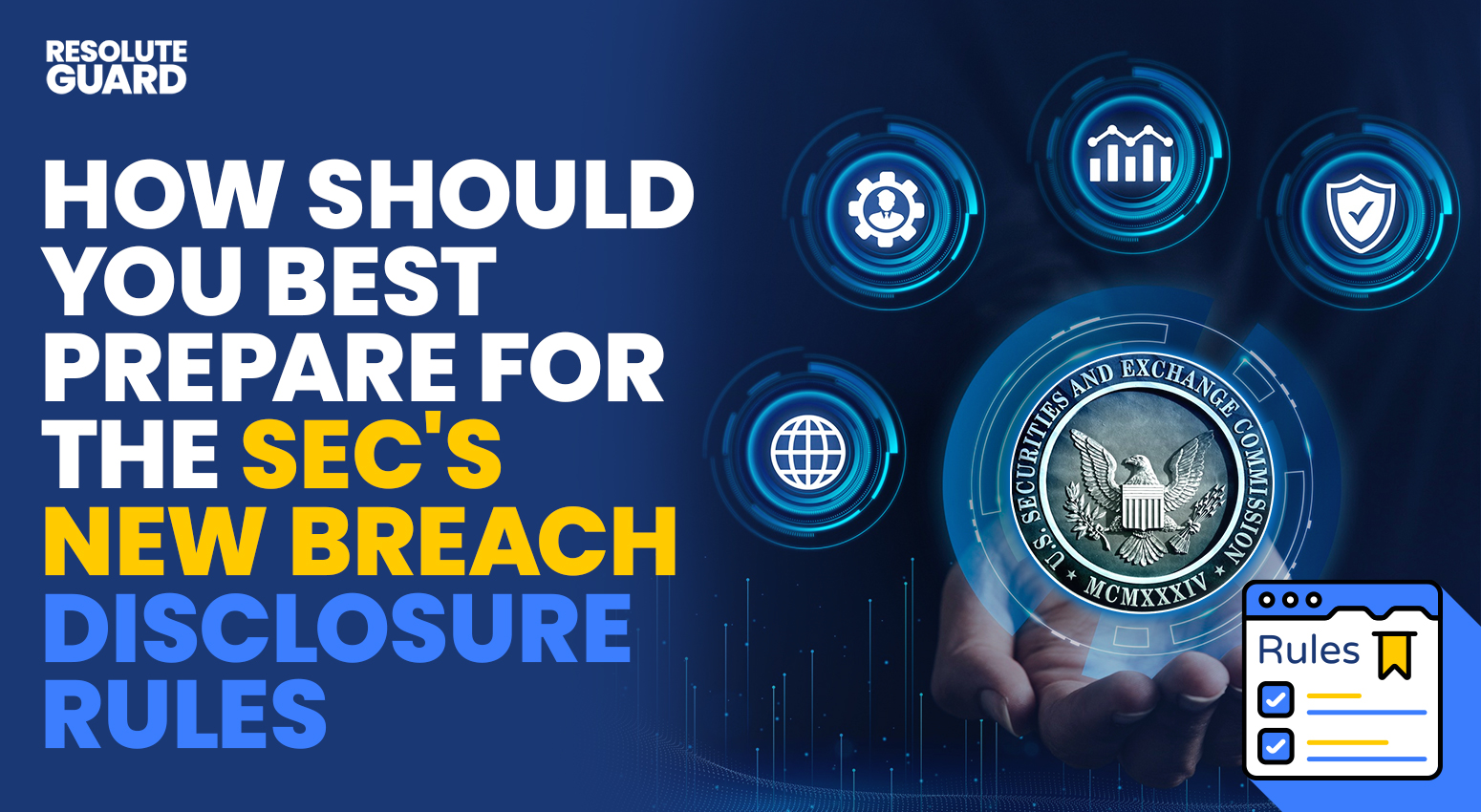How Should You Best Prepare for the SEC’s New Breach Disclosure Rules
To best prepare for the SEC’s new breach disclosure rules, public companies should adopt a comprehensive and proactive approach. Begin by thoroughly understanding the requirements of the new rules, which likely mandate reporting significant cybersecurity incidents within four business days of determining the incident is material. It’s crucial to familiarize yourself with what constitutes a “material” incident, typically defined by its potential impact on an investor’s decision-making process.
Next, establish or update your incident response plan to include procedures for quickly identifying, assessing, and responding to cybersecurity incidents. This plan should incorporate specific steps for complying with SEC disclosure requirements, such as notifying internal stakeholders and preparing the required disclosures promptly. Forming a disclosure committee comprising representatives from legal, compliance, IT, and executive leadership will ensure efficient assessment of incident materiality and oversee the disclosure process.
Regular training and simulations are vital. Provide employees with training on the importance of cybersecurity and the new disclosure requirements, ensuring they understand their roles in incident reporting and response. Conduct incident response simulations that test readiness, including scenarios that require assessing materiality and preparing disclosures.
Enhance your cybersecurity posture by improving defenses, deploying advanced threat detection systems, and ensuring patch management. Continuous monitoring through security information and event management (SIEM) systems can help detect and respond to incidents swiftly. Prepare detailed disclosure templates for different types of incidents, with sections for describing the nature of the incident, impact, response, and mitigation steps. These templates should be reviewed by your legal team to ensure compliance with SEC requirements.
Engage with external legal and cybersecurity experts to review your preparedness and participate in industry forums to stay updated on best practices and developments. Keeping abreast of any updates or changes to the SEC’s proposed rules by regularly checking the SEC’s website and subscribing to relevant newsletters and alerts is essential. Engaging with regulators during public comment periods or industry consultations can also provide valuable insights into the nuances of the rules, helping you prepare accordingly.
It is essential for public companies to ensure that their incident response teams are equipped with the necessary tools and resources to handle potential cybersecurity incidents efficiently. This involves investing in advanced cybersecurity software and technologies that can provide real-time monitoring, threat detection, and incident management capabilities. Implementing robust security measures like multi-factor authentication, encryption, and secure access controls will further fortify your network against breaches.
Developing a culture of cybersecurity awareness within the organization is crucial. Regularly update and refine your cybersecurity policies and procedures, making sure they are accessible and understandable to all employees. Encourage a culture where employees are vigilant and proactive about reporting potential security threats or breaches.
Additionally, companies should engage in continuous learning and improvement by participating in cybersecurity workshops, seminars, and training sessions offered by professional organizations and cybersecurity firms. These educational opportunities can provide valuable insights into the latest threats, defensive strategies, and regulatory updates.
It is also beneficial to establish relationships with external cybersecurity experts and legal advisors who can offer guidance and support when dealing with complex cybersecurity issues and regulatory compliance. Engaging these experts can provide a third-party perspective and help identify potential vulnerabilities that internal teams might overlook.
Maintaining a transparent and open line of communication with stakeholders, including investors, customers, and regulatory bodies, is vital. Regularly update stakeholders on the company’s cybersecurity posture and any measures taken to enhance security. In the event of a breach, timely and transparent communication can help maintain trust and minimize the potential damage to the company’s reputation.
Lastly, regularly review and update your cybersecurity insurance policy to ensure it provides adequate coverage for potential incidents. Cybersecurity insurance can help mitigate the financial impact of a breach by covering costs related to incident response, legal fees, and regulatory fines.
By integrating these advanced strategies and maintaining a proactive approach, public companies can better prepare for the SEC’s new breach disclosure rules, ensuring they are compliant while enhancing their overall cybersecurity posture. This comprehensive approach will not only help in meeting regulatory requirements but also in safeguarding the company’s assets, reputation, and stakeholder trust.
Strengthen Vendor and Third-Party Management
Evaluate Vendor Security:
Ensure that your third-party vendors and service providers comply with your cybersecurity standards. Regularly assess their security posture through audits and compliance checks.
Include security requirements and breach notification clauses in your contracts to ensure that vendors promptly inform you of any security incidents that could affect your data.
Implement a Vendor Risk Management Program:
Establish a comprehensive vendor risk management program to assess and manage the risks associated with third-party relationships. This program should include regular risk assessments, continuous monitoring, and clear policies for addressing identified risks.
Invest in Advanced Threat Intelligence
Utilize Threat Intelligence Services
Subscribe to threat intelligence services that provide insights into emerging threats and vulnerabilities. These services can help you stay ahead of potential risks and adjust your defenses accordingly.
Integrate Threat Intelligence into Security Operations
Incorporate threat intelligence into your security operations center (SOC) to enhance threat detection and response capabilities. This integration enables your team to act quickly on relevant threat information.
Foster a Cybersecurity Culture
Promote Cybersecurity Awareness
Develop a company-wide cybersecurity awareness program to educate employees about the importance of cybersecurity and their role in protecting the organization. Use interactive training modules, regular updates, and phishing simulations to keep security top-of-mind.
Encourage a Security-First Mindset
Foster a culture where cybersecurity is a shared responsibility. Encourage employees to report suspicious activities and reward proactive behaviors that contribute to the organization’s security.
Enhance Data Protection Measures
Implement Data Loss Prevention (DLP) Solutions
Deploy DLP solutions to monitor and protect sensitive data. These tools can help prevent unauthorized access, use, and transmission of confidential information.
Encrypt Sensitive Data
Ensure that sensitive data is encrypted both at rest and in transit. Encryption adds an additional layer of protection and helps ensure that data remains secure even if it is intercepted.
Regularly Review and Update Policies
Conduct Regular Policy Reviews
Regularly review and update your cybersecurity policies to ensure they align with the latest industry standards and regulatory requirements. Make adjustments as needed to address new threats and vulnerabilities.
Ensure Comprehensive Documentation
Maintain detailed documentation of your cybersecurity policies, incident response plans, and breach disclosure procedures. This documentation is essential for demonstrating compliance and for guiding your response during an incident.
Engage in Cybersecurity Exercises
Conduct Tabletop Exercises
Regularly conduct tabletop exercises to simulate cybersecurity incidents and test your organization’s response capabilities. These exercises help identify gaps in your plans and improve coordination among different teams.
Participate in Industry Drills
Engage in industry-wide cybersecurity drills and exercises. These events provide valuable insights into how other organizations handle incidents and offer opportunities to refine your own practices.
Stay Current with Regulatory Developments
Monitor Regulatory Changes
Stay informed about any updates or changes to the SEC’s breach disclosure rules. Regularly check the SEC’s website and subscribe to relevant newsletters to receive timely updates.
Engage with Industry Groups
Participate in industry groups and associations focused on cybersecurity and regulatory compliance. These groups often provide valuable resources, best practices, and opportunities for networking and collaboration.
Leverage Automation and AI
Implement Automation Tools
Use automation tools to streamline repetitive security tasks, such as patch management, log analysis, and incident response. Automation can help reduce the workload on your security team and improve response times.
Explore AI and Machine Learning
Consider leveraging AI and machine learning technologies to enhance your threat detection and response capabilities. These technologies can identify patterns and anomalies that might be missed by traditional security tools.
Develop a Communication Plan
Internal Communication
Establish clear communication protocols for notifying key stakeholders within the organization, including the board of directors, executive team, and legal department, immediately after a cybersecurity incident is identified. This ensures a coordinated response and helps in timely decision-making.
External Communication
Develop a strategy for communicating with external stakeholders such as investors, customers, and regulators. This should include pre-drafted messages and templates that can be quickly customized and deployed in the event of a breach.
Media Relations
Prepare a media relations strategy to handle press inquiries and public statements. Assign a spokesperson trained in crisis communication to manage interactions with the media, ensuring consistent and accurate messaging.
Implement Comprehensive Data Governance
Data Inventory and Classification
Conduct a thorough inventory of all data assets and classify them based on sensitivity and importance. This helps prioritize security measures and ensures critical data receives the highest level of protection.
Data Retention Policies
Establish and enforce data retention policies that specify how long data should be kept and when it should be securely disposed of. Proper data management reduces the risk of exposure and simplifies compliance with regulatory requirements.
Enhance Collaboration with Law Enforcement
Establish Relationships
Build relationships with local, state, and federal law enforcement agencies. This collaboration can provide valuable support and resources in the event of a cybersecurity incident.
Incident Reporting
Develop protocols for reporting cybersecurity incidents to law enforcement. Prompt reporting can aid in investigations and potentially mitigate the impact of a breach.
Perform Regular Security Assessments
Penetration Testing
Conduct regular penetration testing to identify vulnerabilities in your systems. These tests simulate cyberattacks to evaluate the effectiveness of your defenses and uncover weaknesses that need to be addressed.
Vulnerability Assessments
Perform frequent vulnerability assessments to scan for potential security gaps. Use automated tools and manual reviews to ensure comprehensive coverage.
Leverage Cybersecurity Frameworks
Adopt Established Frameworks
Utilize established cybersecurity frameworks such as the NIST Cybersecurity Framework, ISO/IEC 27001, and the CIS Critical Security Controls. These frameworks provide structured approaches to managing and improving your cybersecurity posture.
Continuous Improvement
Regularly review and update your security practices based on feedback and lessons learned from incidents and assessments. Implementing a continuous improvement process ensures your security measures evolve with emerging threats.
Foster a Security-First Culture
Leadership Involvement
Ensure that senior leadership is actively involved in promoting cybersecurity. Their commitment to security sets the tone for the entire organization and underscores the importance of protecting data.
Employee Engagement
Engage employees at all levels in cybersecurity initiatives. Encourage them to share ideas and participate in security training and awareness programs.
Explore Cybersecurity Insurance
Evaluate Coverage Options
Review your current cybersecurity insurance policy and consider additional coverage if necessary. Ensure that the policy covers a wide range of incidents, including data breaches, ransomware attacks, and business interruption.
Regular Policy Reviews
Regularly review and update your cybersecurity insurance policy to ensure it remains aligned with your evolving risk profile and regulatory requirements.
Stay Informed and Proactive
Continuous Education
Stay informed about the latest cybersecurity trends, threats, and best practices. Participate in industry conferences, webinars, and training programs to keep your knowledge up to date.
Proactive Monitoring
Implement proactive monitoring tools and practices to detect and respond to threats in real-time. Use advanced analytics and machine learning to identify anomalies and potential security incidents.
By implementing these additional steps and maintaining a proactive, adaptive approach, public companies can ensure they are well-prepared for the SEC’s new breach disclosure rules. This comprehensive strategy not only helps in meeting regulatory requirements but also enhances the overall security posture of the organization, protecting its assets, reputation, and stakeholder trust. For further detailed guidance, companies can refer to resources from leading cybersecurity bodies such as the National Institute of Standards and Technology (NIST), the Cybersecurity & Infrastructure Security Agency (CISA), and the International Information System Security Certification Consortium (ISC)².

